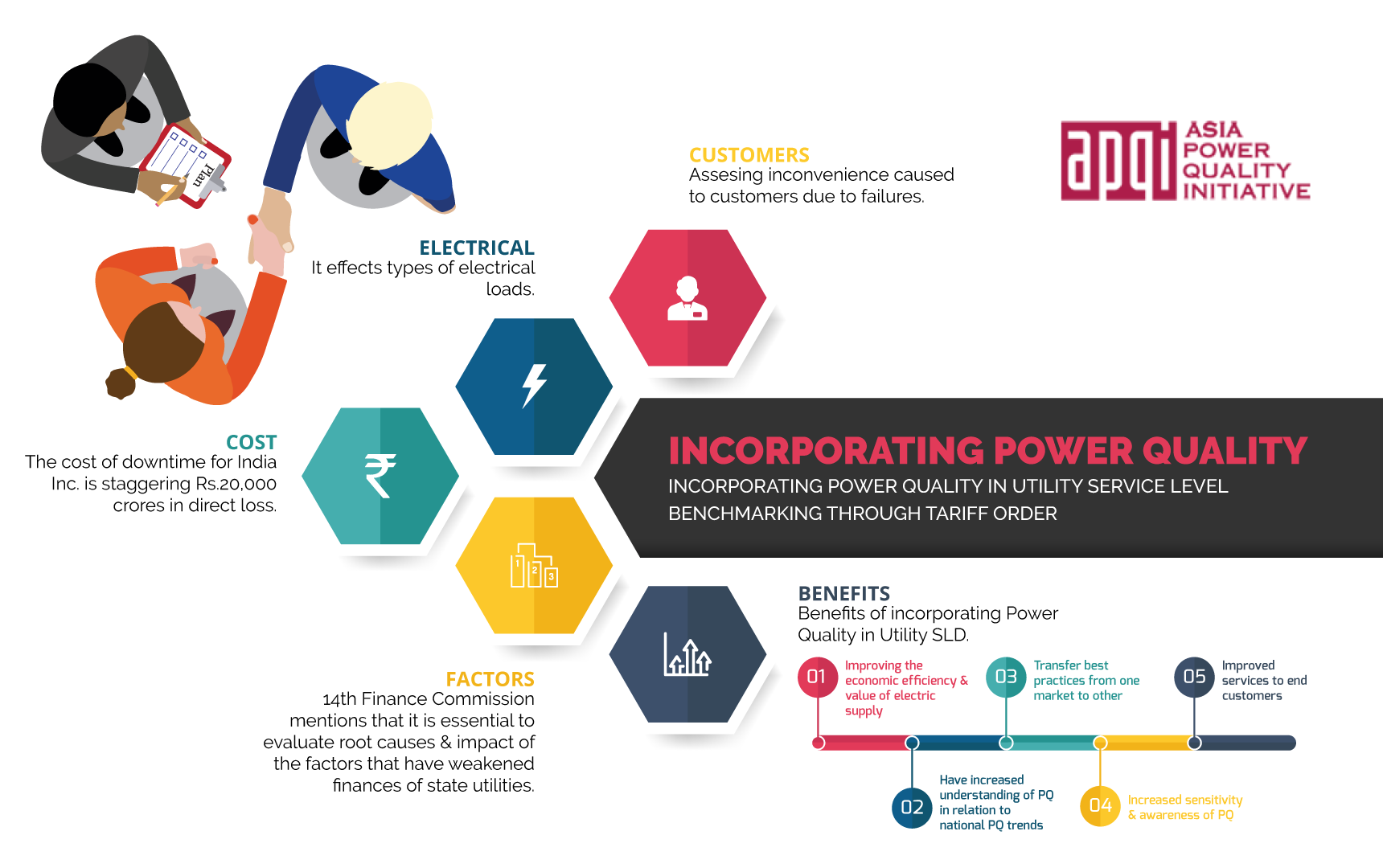Published On: Feb 23, 2017
|
An essential guideline for the implementation of any regulation is that it needs to find the right balance between the interests of different stakeholders. This is particularly important when assessing the inconvenience caused to customers due to failures in the electricity supply. As the Indian Power Sector is policy and regulation driven, hence timely policy and regulatory interventions form the main agent of change that helps the sector run smoothly and efficiently. This blog highlights the importance of incorporating PQ in utility SLB through tariff order leading to a positive impact on network management and financial benefits. With the growing usage of sensitive electronic devices and increasing renewable energy penetration in today’s power system, maintaining Power Quality (PQ) is a tedious task for the utilities. It’s no more only a generation or ‘supply’ side problem, but is dominantly affected by the ‘demand’ side parameters like (a) types of electrical loads and their usage patterns and (b) types of distributed generation interface with the conventional grid. Thus, there is a need to define the quality of electricity provided in a common and succinct manner that can be evaluated internally by the electricity supplier as well as externally by consumers or other interested parties. |
In this state of affairs, the Tariff Order, issued by the regulators, is a key control that can drive all stakeholders to maintain power quality in the system. It has the attention of all stakeholders and so the potential to ensure that PQ starts getting measured regularly & enforced both on Utilities and Customers through right incentive/penalty structure. While there are defined KPIs for measuring Utility supply side reliability performance like SAIDI, CAIDI, etc. there are limited or no strong measures to monitor PQ and benchmark as well. Thus, incorporating PQ parameters in utility Service Level Benchmarking (SLB) will evolve as a strong measure to monitor & understand distribution system’s performance, support customer information and services, or develop systems that anticipate and prevent unwanted levels of PQ variations in the future.
IMPORTANCE OF INCLUDING PQ IN TARIFF ORDER FOR BENCHMARKING UTILITY SERVICESGenerally, most of us don’t bother to do much beyond cursing power utilities whenever a power disruption takes place. And while a power disruption at home may not cost much, the same, if it takes place in a commercial/ industrial sector, can result into loss of crores of rupees. That is exactly what a study commissioned by the Manufacturers Association of Information Technology (MAIT) and Emerson Network Power (India) in 2009 reveals. The cost of downtime for India Inc. is a staggering Rs. 20,000 crores in direct losses due to poor power quality and downtime impact. This accounts for roughly 2% of the gross output of the industrial and service sectors. The superseding goal of PQ benchmarking is to develop an understanding of distribution performance that allows automatic correction of power systems before they fail. It also uncovers previously unseen problems and correct them before significant loss is incurred. Below are the key tasks that help in establishing & developing PQ benchmarking objectives: |
With this status quo, it can be observed that one of the fundamental challenges faced by utility and electricity consumers is to become familiar with and stay informed about issues dealing with power quality. Also, as the utilities undergo restructuring and as customers find their service needs changing, power suppliers & customers alike will find a concrete background in power quality not only useful, but also necessary for continued productivity and competitiveness. Even the Fourteenth Finance Commission (FFC) mentions that it is essential to evaluate the root causes & impact of the factors that have weakened the finances of state utilities.
Hence, power quality benchmarking through tariff order directives will help Indian utilities to focus on quick and cost-effective power performance data to measure their quality levels and ensure that the objective of maintaining a healthy PQ environment is fulfilled.
BENEFITS OF INCORPORATING PQ IN UTILITY SLB
The process of benchmarking power quality enables better understanding of the existing levels of service quality provided to consumers and defines the levels of quality that can be reasonably expected. For today’s customer base, there is a need to recreate the definition of acceptable levels of power quality for key phenomena such as harmonics, voltage sags and other measureable parameters and develop a set of metrics that can be applied at the distribution level.
An increased understanding of utility PQ data can benefit the customers by improving the economic efficiency and value of electric power supply through the improved ability to benchmark and compare PQ performance across many different distribution systems. Utilities, in turn, may benefit from an increased understanding of their system health in relation to national PQ benchmarking trends, thereby providing better information on power system design and its impact on power quality.
Benefits:
- Improving the economic efficiency & value of electric supply
- Have increased understanding of PQ in relation to national PQ trends
- Transfer best practices from one market to other
- Increased sensitivity & awareness of PQ
- Improved services to end customers
Thus, one of the evident benefit of incorporating PQ in SLB would be that the regulators would have more comparable data on the observed power quality levels in different states. In addition, those companies that operate in various markets could more easily transfer their best practices concerning the power quality developments from one market to another.
Beholding these benefits many utilities are implementing PQ measurement and benchmarking standards to establish overall system performance. For example, South African energy company ESKOM, which was interested in understanding the quantity and length of voltage sags, began an in-depth benchmarking project to characterize system performance. The company used benchmarking results to define limits for acceptable numbers of voltage dips per year, depending on the end user’s network voltage range. ESKOM’s results were adopted as the standards for power system voltage sag performance nationwide making South Africa the only country in the world with actual sag performance standards.
Also, the EPRI Reliability Benchmarking Methodology project defined a set of PQ indices that serve as metrics for quantifying quality of service. These indices are calculated from data measured on the system by specialized instrumentation. Many utilities around the world have implemented permanent PQ monitoring systems for benchmarking power quality. However, in India there are still considerably large gaps in coverage of the power system with PQ monitors.
SCOPE FOR IMPROVEMENT - RECOMMENDATION FOR INDIAN UTILITIES
Regulations encourage innovations, both organisational and technological, that benefit the industry in the long run – this applies to power quality developments as well as any other developments within the industry. In India, we have various Regulations specified by CEA, CERC and SERCs for quality of electricity supply which apply to the transmission & distribution companies as well for the consumers to help maintain the standards of the electricity grid. But, these Regulations, when dealing with the aspect of Power Quality, vary and take a back seat in approach, construct and applicability.
The DISCOMs are generally vested with the responsibility of monitoring power factor observed and harmonics injected by consumers. But there is hardly any guideline or enforcement mechanism except in few states. For example, in Tamil Nadu, a HT consumer is liable to pay compensation at 15% of the respective tariff when it exceeds harmonics injection limits specified by CEA. However, the compensation is not levied with respect to the intensity of harmonics injected to the grid. Thus, absence of such regulatory framework leaves a lot of scope for improvement of PQ. A detailed assessment of various regulatory practices in India and abroad can be reviewed in our blog ‘Policy landscape around PQ in India, compared with other rising Economies’
Under such scenario, it is believed that implementing the below recommendations through tariff order may set the track for increasing awareness and sensitivity towards PQ by Indian Utilities and thereby improving their services.
- Mandating installation of Power Quality monitoring instruments at transmission and distribution sub-station and provision for phase wise installation of PQ monitoring systems at sub stations.
- Mandating smart systems for network which communicates the real time information and Power Quality deviations existing in upstream and downstream to all stakeholders.
- Depending on evaluation & benchmarking results, regulators can incentivize/penalize consumers exceeding harmonics limit to maintain and comply with Power Quality norms.
- Increasing the existing penalty applicable for DISCOMs for not complying with voltage and harmonics limit at the points of supply. Penalties shall be such that it creates sufficient deterrent for the offenders of Regulations.
Prescribing tariff incentive / penalty mechanism for customers to observe harmonic limits so as to prevent unbearable pollution of upstream power system thereby affecting other customers as well.
CONCLUSION
Thus, in this world of competition, incorporating Power Quality measures in electricity Service Level Benchmarking will not only help in improving the quality of power delivered to end users but also in controlling the costs of the services delivered. To ensure high PQ to consumers, it is important that the quality of supply be linked with tariffs and tariffs be revised in accordance with the improvement in quality.
Including PQ in tariff orders will thus make it mandatory for all stakeholders to abide by the rules & prescribed limits. Thereby making the sensitivity and awareness of economic impact of Power Quality in India go up from moderate to high.
REFERENCES
- E-Source researches power quality benchmarking by Steve Hoffman, 12 October, 2000
- Benchmarking of Data for Power Quality Evaluation by L.P. Singh, D.K. Singh and S.P. Jain, 14 November, 2011
- Benchmarking of Power Quality Performance in Transmission Systems – CIGRE WG C4.27 Perspective by Jako Kilter, Davor Vujatovic, Sean Elphick, Herwig Renner, John van Coller and Frans van Erp, 2016
- Power sector operations and impact on state Finances prepared for The Fourteenth Finance Commission, August 2014
- Power Quality Issues and its Parameters Measurement Technique with Improvement Features in a Distribution System by B. K. Prusty & S. M. Ali, 2003









